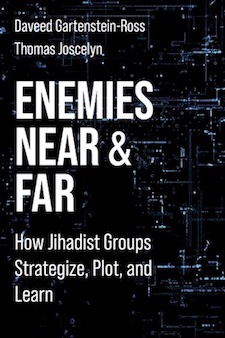SWJ Book Review – Enemies Near and Far: How Jihadist Groups Strategize, Plot, and Learn
John P. Sullivan

Daveed Gartenstein-Ross and Thomas Joscelyn, Enemies Near and Far: How Jihadist Groups Strategize, Plot, and Learn. New York: Columbia University Press, 2022 [ISBN: 9780231195256. Paperback, 512 Pages]
Terrorists evolve and adapt to achieve their goals. This adaptation includes embracing new tactics, techniques, and procedures (TTPs), as well as setting strategic goals and objectives. Over time this involves calibrating ways and means toward achieving organization and ideological aims, responding to competing groups, and overcoming the counterterrorism efforts of state security services. This calibration of tactical and strategic aspects of jihadi terrorism is explored in Enemies Near & Far: How Jihadist Groups Strategize, Plot, and Learn.
The text is part of the Columbia Studies in Terrorism and Irregular Warfare series edited by Bruce Hoffman. Daveed Gartenstein-Ross and Thomas Joscelyn are accomplished counterterrorism specialists. Gartenstein-Ross, a lawyer and PhD in world politics is the author or editor of over 25 books and monographs and helped frame the US Department of Homeland Security’s strategic framework for countering terrorism. He is CEO of Valens Global and is a senior advisor at the Foundation for the Defense of Democracies. Joscelyn, a Senior Fellow at the Foundation for the Defense of Democracies and Senior Editor of its Long War Journal also served as a consultant to the FBI’s Counterterrorism Division.
Setting the Stage
Enemies Far & Near is a well-researched and comprehensive examination of the organizational culture and strategic preferences of al-Qaeda and the ISIS and their many allies. The text looks at how the two groups formed, conducted operations, morphed, ultimately separated, and became competitors for primacy in the jihadist nebula. Organizationally, the text is divided into 11 chapters, each containing a detailed assessment of both groups’ evolution and organizational choices. Theoretically, the book assesses failures to recognize and anticipate jihadi terrorist evolution. The authors’ argue that ‘consensus failures’ lead to flawed intelligence analysis that results in missing key terrorist advances or strategic imperatives. The three cases they examine include the Arab Spring revolutions, the competition between al-Qaeda and ISIS, and the myth of lone-wolf terrorism. Rather than accepting the analytic flavor of the day, the authors suggest analyzing the organizational learning paradigm embraced by each terrorist group would yield more accurate assessments of their capabilities and intentions. Chapter 1, “The Fire Next Time” provides an outline of their assessment toward providing a framework for anticipating jihadist groups’ plots, strategies, and trajectories. Chapter 2, “Learning to Win” provides a detailed literature review on organizational learning and then cross-walks these findings with a detailed articulation of a four-phase technology adoption curve. This is a major theoretical contribution to the literature and provides a sound foundation for analyzing the interaction between organizational learning and technological choice.
From Far Enemies to the Rise and Fall of ISIS
The ideological development of al-Qaeda’s targeting preferences is the topic of Chapter 3, “The Far Enemy Strategy.” As we now know, this Far Enemy strategy led to the 9/11 attacks and ushered in two decades of jihadist evolution and competition with the West and between contenders for leadership of the jihadist movement. Chapter 4, “The Unfriendly Skies: Plots Against Aviation” describes the tactical and technological targeting choices behind aviation attacks: from using aircraft as weapons, to liquid explosives, to the secreting bombs in underwear or printer cartridges. Chapter 5, “The Early Adopter: Anwar al-Awlaki in the Digital Space” looks at the use of new communications techniques, such as Internet communications technology (ICT) and social media to reach new audiences, forge opportunities for ‘individual jihad’ and set the stage for ‘virtual plotters.’ Chapter 6, “Strategic Learning: Al-Qaeda and Jihadism in the Arab Spring” describes how jihadists exploited these ‘revolutions’ to shape the information environment in the region and fill the vacuums of power created by the turbulent quest for social change. The al-Qaeda-ISIS split is recapped in Chapter 7, “The Islamic State’s Rise and Fall.” The rise of ISIS’s self-proclaimed caliphate exposed weaknesses in the al-Qaeda approach. The competition between these two organizations and their apparently diametrically opposed approaches is dissected in Chapter 8, “The Fitna: ISIS Versus al-Qaeda.” Here, we see that al-Qaeda used strategic patience to regain momentum and survive the strife between the competing approaches.
Now and Future Jihadist Activity and Beyond…
The protean nature of both approaches to jihad is assessed in Chapter 9, “How al-Qaeda Survived the War in Afghanistan” and Chapter 10, “ISIS’s External Operations a Study in Innovation.” The text concludes with an evaluation of jihadist organizational learning. The conclusion, Chapter 11, “The Past and Future of Jihadist Organizational Learning” recaps the case studies presented in detail in the preceding analysis. After summarizing the strategic evolution of al-Qaeda and ISIS, the authors discuss past evolution of jihadist TTPs and assess future tactical jihadist potentials. These future threats (TTPs) include drones and artificial intelligence. The authors then conclude by suggesting ways to avoid consensus errors, analytic failure, and myopia (such as mirror imaging, biases, and groupthink). These methods include red teaming and the continuing development of analytic skills.
Enemies Near and Far is a conceptual masterpiece. It summarizes two decades of comprehensive with intellectual rigor. It is well sourced and integrates primary sources with analytic experience to illustrate how organizational learning and adaptation influence strategic and tactical choice. This work is clearly of benefit to counterterrorist analyst, investigators, and scholars. It also deserves a place on the book shelves of specialists in jihadi groups. But it should not be limited to the jihadist threat. Its insights on adaptation and organizational learning are also useful to those analyzing all facets of non-state threat from globally networked right-wing extremism to transnational organized crime.

